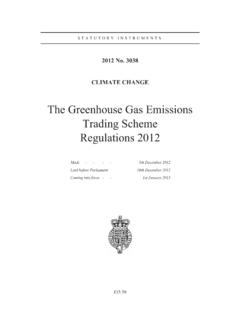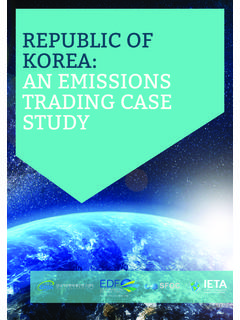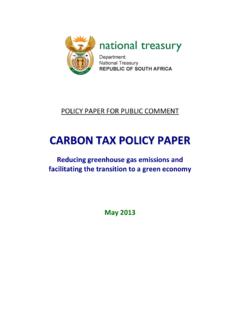Transcription of OECD Environmental Outlook to 2050
1 OECD Environmental Outlook to 2050 Climate Change ChapterPRE-RELEASE VERSIONN ovember 1 OECD Environmental Outlook TO 2050 CHAPTER 3: CLIMATE CHANGE PRE-RELEASE VERSION, NOVEMBER 2011 The OECD Environmental Outlook to 2050 was prepared by a joint team from the OECD Environment Directorate (ENV) and the PBL Netherlands Environmental Assessment Agency (PBL). Authors: Virginie Marchal, Rob Dellink (ENV) Detlef van Vuuren (PBL) Christa Clapp, Jean Ch teau, Eliza Lanzi, Bertrand Magn (ENV) Jasper van Vliet (PBL) Contacts: Virginie Marchal Rob Dellink 2 TABLE OF CONTENTS Key messages .. 5 Trends and projections .. 5 Policy steps to build a low-carbon, climate-resilient economy .. 6 Introduction.
2 9 Trends and projections .. 9 Greenhouse gas emissions and concentrations .. 9 Impacts of climate change .. 17 Climate Change: The state of policy today .. 23 The international challenge: Overcoming inertia .. 23 National action to mitigate climate change .. 24 National action to adapt to climate 38 Getting the policy mix right: Interactions between adaptation and mitigation .. 42 Policy steps for tomorrow: Building a low-carbon, climate-resilient economy .. 43 What if ..? Three scenarios for stabilising emissions at 450 ppm .. 43 Less stringent climate mitigation (550 ppm) scenarios .. 62 Actions needed for an ambitious, global climate policy framework .. 63 Finding synergies among climate change strategies and other goals.
3 66 NOTES .. 71 REFERENCES .. 75 ANNEX : MODELLING BACKGROUND INFORMATION ON CLIMATE CHANGE .. 83 The Baseline scenario .. 83 The 450 ppm climate stabilisation scenarios .. 84 Alternative permit allocation schemes .. 84 Technology options in the 450 ppm scenario .. 85 Canc n Agreements/Copenhagen Accord pledges .. 86 Phasing out fossil fuel subsidies .. 88 ANNEX NOTES .. 89 Tables Table Examples of policy tools for climate change mitigation .. 25 Table National climate change legislation: Coverage and scope, selected countries .. 27 Table Status of emission trading schemes .. 29 Table Adaptation options and potential policy instruments .. 39 Table Overview of the Environmental Outlook mitigation scenarios.
4 44 Table How targets and actions pledged under the Copenhagen Accord and Canc n Agreements are interpreted as emission changes under the 450 Delayed Action scenario: 2020 compared to 1990 .. 57 How different factors will affect emissions and real income from the Canc n Agreements/Copenhagen Accord pledges: 450 Delayed Action scenario) .. 59 3 Competitiveness impacts of the 450 Delayed Action scenario, 2020 and 2050: % change from Baseline .. 61 Table Income impacts of a fossil fuel subsidy reform with and without the 450 Core scenario, 2020 and 2050: % real income deviation from the Baseline .. 66 Table Economic impact of an OECD-wide emissions trading scheme where labour markets are rigid, assuming lump-sum redistribution, 2015-2030: % deviation from the business-as-usual scenario.
5 70 Table Economic impact of an OECD-wide ETS for different recycling options, assuming medium labour market rigidity, 2015-2030 .. 70 Figures Figure GHG emissions: Baseline, 1970- 2005 .. 10 Figure Decoupling trends: CO2 emissions versus GDP in the OECD and BRIICS, 1990-2010 .. 11 Figure Energy related CO2 emission per capita, OECD/ BRIICS, 2000 and 2008 .. 12 Figure Change in production-based and demand-based CO2 emissions: 1995- 2005 .. 13 Figure GHG emissions to 2050; Baseline, 14 Figure GHG emissions per capita: Baseline, 2010-2050 .. 14 Figure Global CO2 emissions by source: Baseline, 1980-2050 .. 15 Figure CO2 emissions from land use: Baseline, 1990-2050 .. 16 Figure Long-run CO2-concentrations and temperature increase; Baseline1970-2100.
6 17 Figure Change in annual temperature: Baseline and 450oppm scenarios, 1990-2050 .. 18 Figure Change in annual precipitation: Baseline, 1990-2050 .. 19 Figure Key impacts of increasing global temperature .. 20 Figure Assets exposed to sea-level rise in coastal cities by 2070 .. 22 Figure Government RD&D expenditures in energy in IEA member countries: 34 Figure New plant entry by type of renewable energy in North America, Pacific and EU-15 regions, 1978-2008 .. 35 Figure Alternative emission pathways, 2010-2100 .. 45 Figure Concentration pathways for the four Outlook scenarios including all climate forcers, 2010-2100 47 Figure 450oCore Scenario: emissions and cost of mitigation, 2010-2050.
7 48 Figure Impact of permit allocation schemes on emission allowances and real income in 2050 .. 51 Figure GHG abatements in the 450 Core Accelarated Action and 450 Core scenarios compared to the Baseline, 2020 and 2030 .. 53 Figure Technology choices for the 450 Accelerated Action scenario .. 55 Regional real income impacts: 450 Core versus 450 Delayed Action scenarios .. 58 Change in global GHG emissions in 2050 compared to 2010: 450 Delayed Action and 550oppm scenarios .. 62 Figure Change in real income from the Baseline for the 450 Delayed Action and 550 Core scenarios, 2050 63 Figure Income impact of fragmented emission trading schemes for reaching concentrations of 550oppm compared to the Baseline, 2050.
8 64 Impact on GHG emissions of phasing out fossil fuels subsidies, 2050 .. 65 Figure Permit allocation schemes, 2020 and 85 Figure Nuclear installed capacity in the Progressive nuclear phase out scenario, 2010-2050 .. 86 Boxes Box Production versus demand-based emissions .. 13 Box Land-use emissions of CO2 past trends and future projections .. 16 Box Example of assets exposed to climate change: Coastal cities .. 22 4 Box The EU-Emissions Trading Scheme: Recent developments .. 30 Box The growth in renewable energy power plants .. 35 Box Greening household behaviour: The role of public policies .. 37 Box The UNEP Emissions Gap report .. 46 Box Cost uncertainties and modelling frameworks .. 49 Box What mitigation burden was shared differently?
9 How permit allocation rules matter50 Box Implications of technology options .. 54 Box Mind the gap: Will the Copenhagen pledges deliver enough? .. 59 Box What a global carbon market does not emerge? .. 64 Box Bioenergy: Panacea or Pandora s Box? .. 67 Box The case of black carbon .. 68 Box What GHGs could increase employment? .. 69 5 Key messages Climate change presents a global systemic risk to society. It threatens the basic elements of life for all people: access to water, food production, health, use of land, and physical and natural capital. Inadequate attention to climate change could have significant social consequences for human well-being, hamper economic growth and heighten the risk of abrupt and large-scale changes to our climatic and ecological systems.
10 The significant economic damage could equate to a permanent loss in average per-capita world consumption of more than 14% (Stern, 2006). Some poor countries would be likely to suffer particularly severely. This chapter demonstrates how avoiding these economic, social and Environmental costs will require effective policies to shift economies onto low-carbon and climate-resilient growth paths. Trends and projections Environmental state and pressures RED Global greenhouse gas (GHG) emissions continue to increase, and in 2010 global energy-related carbon-dioxide (CO2) emissions reached an all-time high of gigatonnes (Gt) despite the recent economic crisis. The Environmental Outlook Baseline scenario envisages that without more ambitious policies than those in force today, GHG emissions will increase by another 50% by 2050, primarily driven by a projected 70% growth in CO2 emissions from energy use.

















